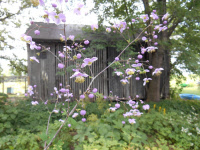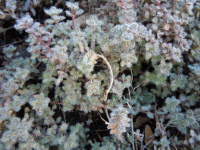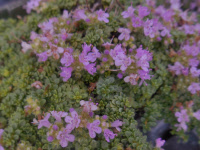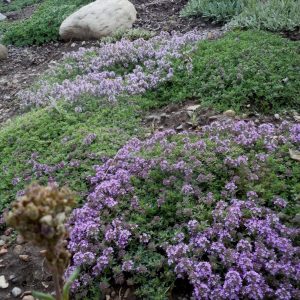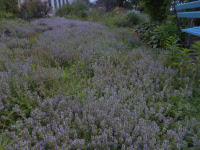Shop
Showing 737–744 of 788 results
-
Thalictrum rochebruneanum Lavender mist meadowrue Z 4-7
Lacy, fine-textured, bluish-green, pinnately compound, columbine-like foliage topped by pendulous, lavender-purple flowers (sepals) with yellow stamens July-September in airy clusters rising well above the foliage to 4-6' tall. Extraordinary en mass. One of internationally known garden designer Piet Oudolf's 100 "MUST HAVE" plants, Gardens Illustrated.
Lacy, fine-textured, bluish-green, pinnately compound, columbine-like foliage topped by pendulous, lavender-purple flowers (sepals) with yellow stamens July-September in airy clusters rising well above the foliage to 4-6′ tall. Extraordinary en mass. One of internationally known garden designer Piet Oudolf’s 100 “MUST HAVE” plants, Gardens Illustrated.
Size: 6’ x 30”
Care: sun to part shade in moist well-drained soil
Native: Japan
Wildlife Value: Attracts Black swallowtail butterfly
Awards: Missouri Botanic Garden Plant of MeritThalictrum is from Greek meaning “to flourish” or “look green.” This species collected before 1878. Likely named for French botanist Alphonse Trémeau de Rochebrune (1834-1912).
-
Thermopsis caroliniana syn. Thermopsis villosa Carolina lupine Z 4-9
Dense spikes of buttery yellow in June, resembling Baptisia or Lupin with clover like foliage.
ARCHIVED
Note: This is a plant not currently for sale. This is an archive page preserved for informational use.
Dense spikes of buttery yellow in June, resembling Baptisia or Lupin with clover-like foliage.
Size: 4’ x 2’ spreading
Care: Sun in well-drained soil. Drought & Heat tolerant.
Native: forest openings in the Appalachians
Wildlife Value: Attracts bees & butterflies, Deer & rabbit resistant.Collected before 1843
-
Thermopsis lanceolata Lanceleaf thermopsis, Siberian lupin Z 3-8
Brilliant spikes of buttercup yellow pea-like flowers June-July
ARCHIVED
Note: This is a plant not currently for sale. This is an archive page preserved for informational use.
Brilliant spikes of buttercup yellow pea-like flowers June-July
Size: 3’ x 18”
Care: sun to part shade in well-drained to moist well-drained soil
Native: E. Asia, Siberia to Japan & AlaskaThermopsis is Greek meaning “lupin” and “like;” lanceolata refers to the lance shaped leaves. Named by Carl Linnaeus, the father of botanical nomenclature. This species collected before 1753.
-
Thermopsis montana syn. T. rhombifolia Golden banner, False lupin Z 4-9
Yellow spikes of pea-like flowers May-June and longer in cool climates.
ARCHIVED
Note: This is a plant not currently for sale. This is an archive page preserved for informational use.
Yellow spikes of pea-like flowers May-June and longer in cool climates.
Size: 24-36” x 18-24” & spreading by rhizomes
Care: sun to part shade in moist well-drained to well-drained soil
Native: Rocky MountainsThermopsis is Greek meaning “lupin” and “like;” because the flower looks like a yellow lupine. Collected in 1834 by plant hunter extraordinaire Thomas Nuttall (1786-1859) on the trip to California, the Wyeth Expedition.
-
Thymus pseudolanuginosus Woolly thyme Z 4-8
Wonderful groundcover or in rock gardens for its miniature, very hairy silver leaves, resembling wool. Lavender flowers in June.
Grown as a groundcover or in rock gardens for its miniature, very hairy silver leaves, resembling wool. Lavender flowers in June.
Size: 1” x 12” spreading slowly
Care: sun to part shade in well-drained soil.
Native: Europe
Wildlife Value: Drought tolerant. Deer resistantThymus from the Greek word for “odor” due to the plant’s fragrance. Ancient Greeks made incense with thyme. This species 1st mentioned in Gardeners Dictionary by Phillip Miller of Chelsea Physic Garden fame, 1771.
-
Thymus serpyllum ‘Minus’ syn. T. praecox ‘Minus’ Dwarf thyme Z 2-9
Purple flowers cover evergreen foliage in late spring on this tiny thyme-leaved plant. Good groundcover or for rock gardens
Purple flowers cover evergreen foliage in late spring on this tiny thyme-leaved plant. Good groundcover or for rock gardens
Size: 3” x 12” and spreading
Care: sun to part shade in moist well-drained to well-drained soil
Native: Europe
Wildlife Value: Deer resistant.
Size: Great for rock gardens, groundcover, drought tolerant.Thymus from the Greek word for “odor” due to the plant’s fragrance. Ancient Greeks made incense with thyme. ‘Minus’ described by Parkinson in 1640. He called it Thymus serphyllum vulgare minus.
-
Thymus serpyllum ssp. arcticus syn. T. praecox Lemon thyme Z 2-9
Purple flowers May – August with evergreen foliage on this tiny leaved plant. Good for groundcover or rock garden.
ARCHIVED
Note: This is a plant not currently for sale. This is an archive page preserved for informational use.
Purple flowers May – June with evergreen foliage on this tiny leaved plant. Good for groundcover or rock garden.
Can not ship to: Maryland
Size: 4” x 12” and spreading
Care: sun to part shade in moist well-drained to well-drained soil
Native: Greenland, Norway, Iceland, the Arctic, much of the US incl WI.This species collected on an expedition in the Arctic before 1855.
-
Thymus serpyllum syn. Thymus praecox Mother-of-thyme, creeping thyme Z 4-9
Short purple spikes in June-July
Short purple spikes in June-July
Size: 3” x 24”
Care: sun in well-drained soil
Native: Europe & Western Asia
Size: groundcover, rock garden, herb, fragrant foliage, thyme lawnThymus from the Greek word for “odor” due to the plant’s fragrance. Ancient Greeks made incense with thyme. This species since at least 1753. Acc’d to Parkinson in 1640 this remedied hysterics in women. Wm. Robinson wrote,”nothing can be more charming than a sunny bank covered with” Thymus serpyllum. LH Bailey extolled it as “prized as an evergreen edging and as cover for rockwork and waste places …The leaves are sometimes used for seasoning.”

